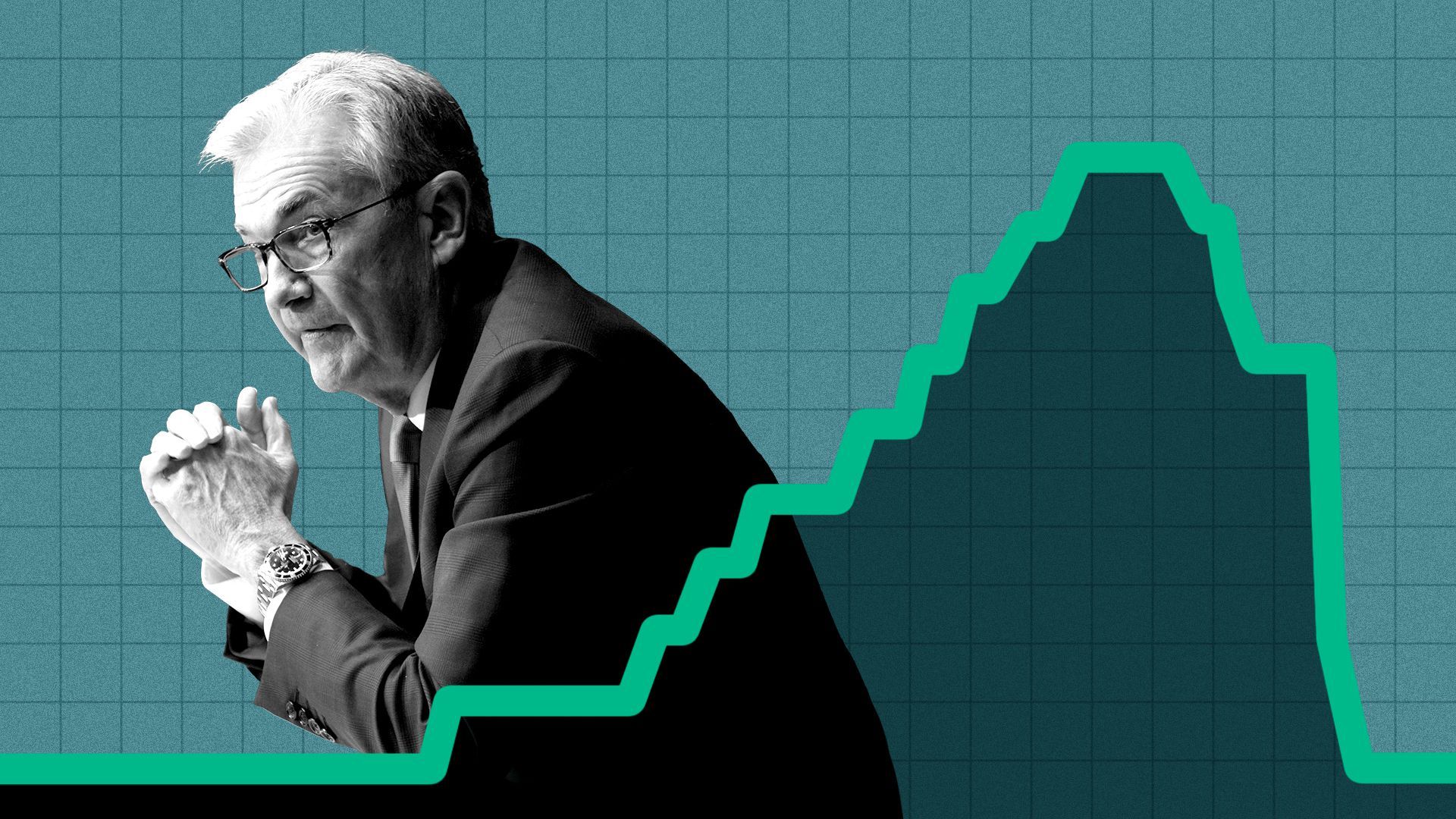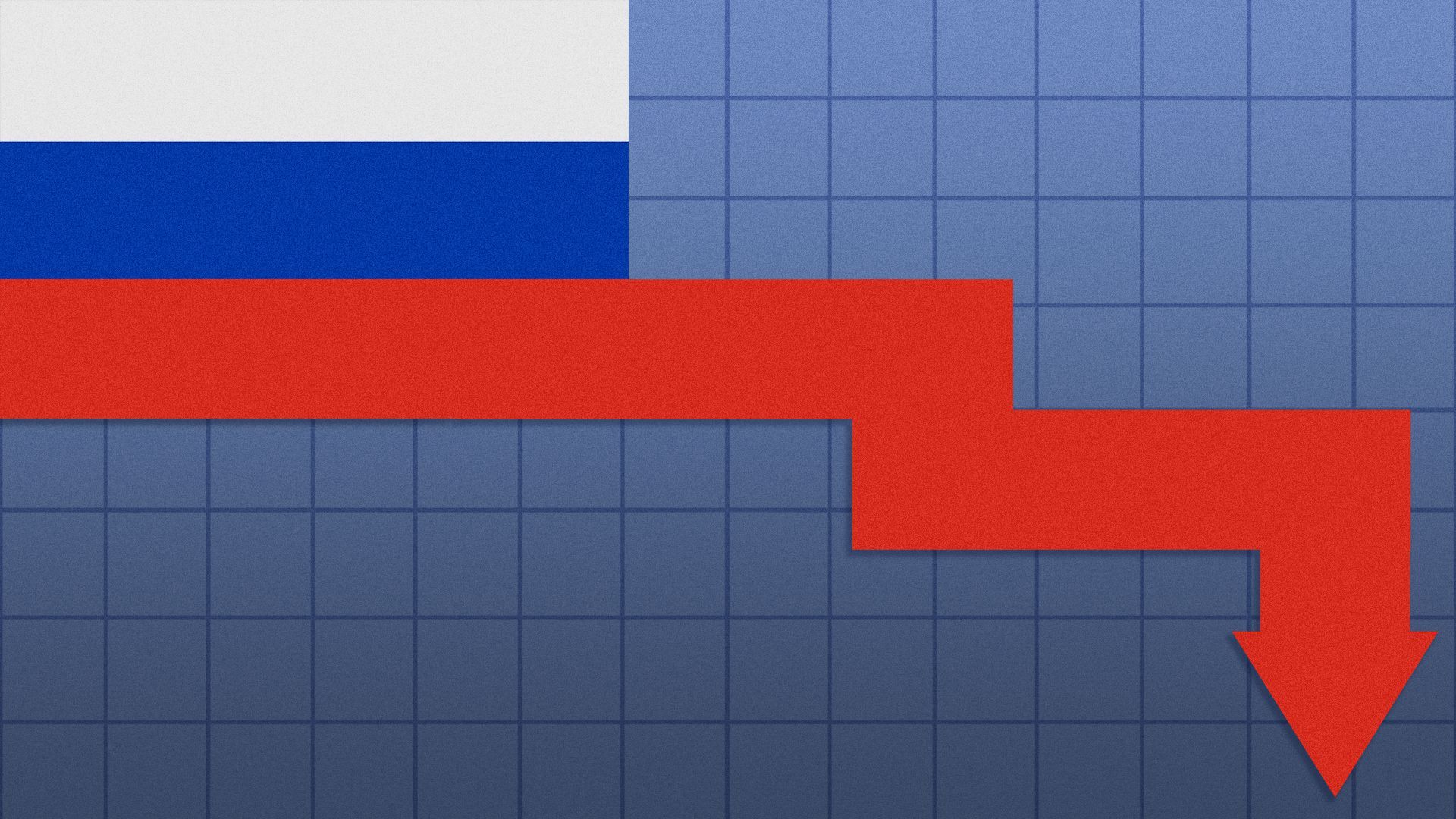| | | | | | | | | | | Axios Markets | | By Matt Phillips and Emily Peck ·Mar 14, 2022 | | 🥧 Oh hey, we're back. And, it's 3.14. Pi Day! A fantastic excuse to have dessert on a Monday. Today's newsletter is 1,097 words, 4.5 minutes. | | | | | | 1 big thing: Fed looks to get less behind-the-curve |  | | | Photo Illustration: Brendan Lynch/Axios. Photo: Brendan Smialowski/Getty Images | | | | The Federal Reserve's policy committee meets this week and will almost certainly raise interest rates by a quarter of a percentage point. It will be a first baby step in what looks to be a long and arduous path to reduce inflation, Axios' Neil Irwin writes. Why it matters: The Fed's navigation of an economic tightrope will determine whether the next couple of years feature a recession, sustained sky-high inflation, neither or both. - With inflation nearing 8%, and unemployment below 4%, the Fed is, by any historical standard, far behind the curve in raising rates.
- Its dilemma: How to correct that without crashing the economy, a task made more difficult by the Ukraine war and new COVID-induced lockdowns in China.
Chair Jerome Powell is betting on "neither." But achieving that is looking like a gnarly challenge, given how far the current policy stance is from what we'd typically expect to act as a brake on growth and inflation. Flashback: It was one year ago exactly that the Fed started to fall behind the curve on aligning its policy stance with economic conditions on the ground. Consider the timeline: - In December 2020, the economy still in shambles, Fed officials forecast they'd keep interest rates near zero through at least the end of 2023.
- Between that meeting and March 2021, Congress passed a bipartisan $900 billion pandemic aid package, Democrats captured the Senate in Georgia special elections, the Biden administration's $1.9 trillion rescue plan passed, COVID vaccines became widely available — and inflation figures started to perk up.
But the outlook for Fed policy didn't change at the March 2021 meeting, despite those dramatic shifts in the outlook for fiscal policy and public health. - Fed leaders didn't want to repeat the mistake of the 2010s, with a hasty tightening that risked slowing the jobs recovery prematurely. With perfect hindsight, of course, that left them stuck in a stance of super-easy monetary policy even as economic growth surged and inflationary pressures mounted.
State of play: Now, the Fed prepares to take that first step toward tighter money. As importantly, at this week's meeting, the central bank leaders will update their rates forecasts — and that will tell us where the consensus lies on how fast they can move. - The Fed believes the longer-term "neutral rate," which neither stimulates nor slows the economy, is around 2.5%. It would take a total of 10 quarter-point moves this year just to reach that.
- Forecasters are expecting somewhat less than that, maybe six rate hikes this year with more in 2023.
The bottom line: Powell has aimed to move cautiously in his tightening campaign, in part to avoid adding more uncertainty in an unsettled time. The tradeoff is that the Fed is now playing catch-up. |     | | | | | | 2. Catch up quick | | 📱Apple supplier Foxconn is halting operations in Chinese port city and tech hub Shenzhen amid COVID lockdowns. (Bloomberg) 📉 JPMorgan led talks with a Chinese metals giant to resolve the nickel market crisis that led to a trading halt last week. (WSJ) 💰Russia warned companies like Coca-Cola, McDonald's and Procter & Gamble it could seize their assets. (WSJ) |     | | | | | | 3. Inflation expectations keep rising |  Data: FactSet; Chart: Axios Visuals Both regular people and Wall Street sophisticates are ratcheting up expectations for inflation, in what wonks worry could be the start of a self-fulfilling prophecy, Matt writes. Driving the news: A market-based reading of inflation expectations — often referred to as a five-year breakeven — shot to the highest level on record this week. - This number is derived by comparing the yields on Treasury bonds to a separate Treasury that's protected against losses from inflation.
- At its current level of 3.5 percentage points, it suggests that investors now expect inflation to average roughly 3.5% a year for the next five years.
Separately, a survey from the University of Michigan on Friday showed shorter-term inflation expectations among American consumers rising to their highest level since 1981. Why it matters: Economists theorize that there is a strong psychological component to inflation. In other words, when people expect prices to rise, they can behave in ways that actually cause prices to rise. How it (theoretically) works: - Workers expect higher prices.
- They ask for higher wages.
- Employers raise wages but need to pay higher labor costs.
- Employers raise prices of their products.
- Workers see higher prices.
- Repeat.
The bottom line: The Fed — and other central bankers — are going to view the recent rise in inflation expectations as another reason to proceed with rate increases. |     | | | | | | A message from Axios | | Get smarter, faster about your industry | | |  | | | | Axios Pro delivers the news you need to understand what's shaping your industry. What you'll get: Daily newsletters, exclusive scoops and in-depth analysis backed by decades of industry experience. Try it free for two weeks. | | | | | | 4. America is sad |  Data: University of Michigan, FactSet; Chart: Axios Visuals Morale among American consumers — sometimes referred to as "people" — deteriorated early this month, as the already dour post-COVID mood was not improved by worsening inflation or the arrival of a major European land war, Matt writes. Driving the news: That University of Michigan survey showed that overall consumer sentiment dropped for the fifth time in the last six months in March, falling to an almost 11-year low. Why it matters: "Why does anything matter?" our morose average American might ask. - In all seriousness, the sour public mood suggests that inflation worries have totally eclipsed other indicators that show a pretty strong U.S. economy — such as unemployment at just 3.8%.
- It also bodes particularly ill for elected officials hoping not to be, well, unelected.
|     | | |  | | | | If you like this newsletter, your friends may, too! Refer your friends and get free Axios swag when they sign up. | | | | | | | | 5. Echoes of divestment |  | | | Illustration: Shoshana Gordon/Axios | | | | The corporate pullout from Russia happened faster than anyone could have imagined, drawing comparisons to the wave of company disinvestment in South Africa in the 1980s, Emily writes. Driving the news: Since the invasion last month, more than 300 global companies announced some kind of withdrawal from the country, according to the tally kept by management professor Jeffrey Sonnenfeld and his team at Yale. - The list is a who's who of the corporate world — from Amex to YouTube.
There were three waves of a corporate retreat, Sonnenfeld tells Axios. - First movers were driven by principle and employee outrage.
- The next group was responding to the financial markets or consumer protests, fearing "backlash and boycotts."
- Finally, the third group was anxious about getting trapped or "identified as being on the wrong side of history."
About 30 companies based outside Russia haven't said they'll withdraw, according to his list, which is updated continuously. - "There is still a group putting out smokescreen PR blather trying to have it both ways," Sonnenfeld said.
Flashback: Sonnenfeld and others are comparing the pullback to the mid-1980s divestment from apartheid South Africa. - This is going much faster. Back then company action "followed 30 years of activism and many companies did so grudgingly," said Paul Washington, executive director at the Conference Board.
- Companies did eventually return to South Africa after Nelson Mandela was freed from prison and apartheid was dissolved.
|     | | | | | | A message from Axios | | Get smarter, faster about your industry | | |  | | | | Axios Pro delivers the news you need to understand what's shaping your industry. What you'll get: Daily newsletters, exclusive scoops and in-depth analysis backed by decades of industry experience. Try it free for two weeks. | | |  | It's called Smart Brevity®. Over 200 orgs use it — in a tool called Axios HQ — to drive productivity with clearer workplace communications. | | | | | | Axios thanks our partners for supporting our newsletters. If you're interested in advertising, learn more here.
Sponsorship has no influence on editorial content. Axios, 3100 Clarendon Blvd, Suite 1300, Arlington VA 22201 | | | You received this email because you signed up for newsletters from Axios.
Change your preferences or unsubscribe here. | | | Was this email forwarded to you?
Sign up now to get Axios in your inbox. | | | | Follow Axios on social media:    | | | | | |












No comments:
Post a Comment